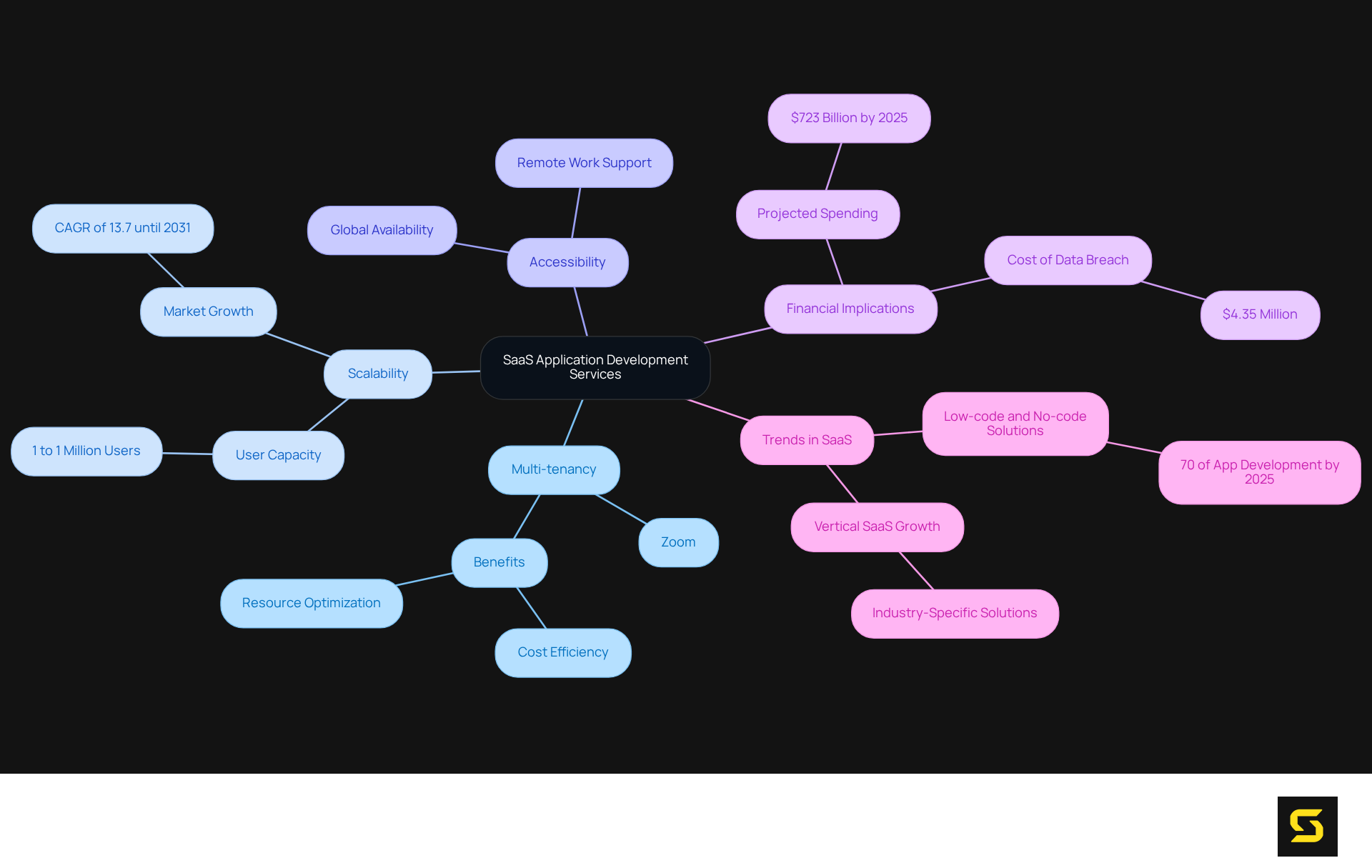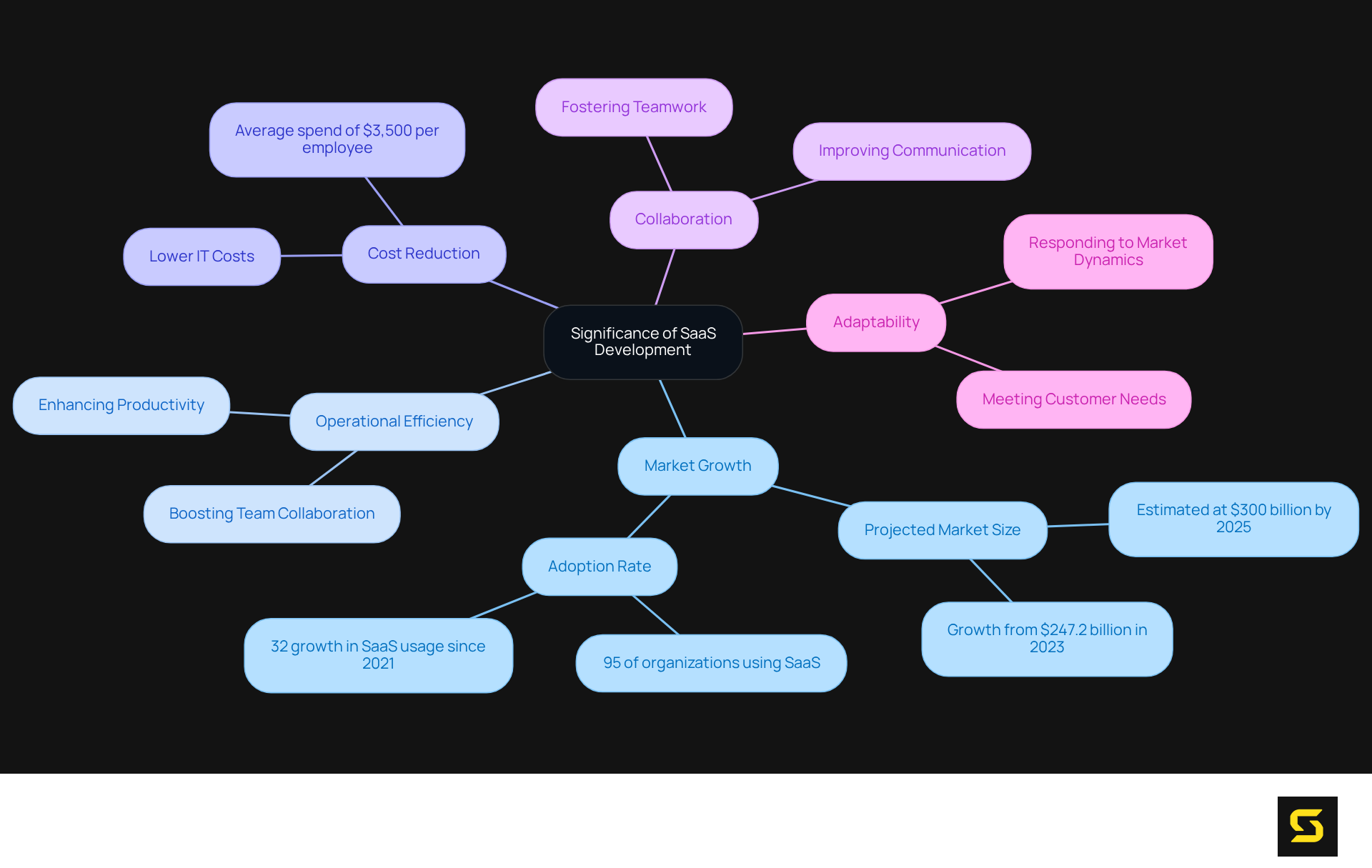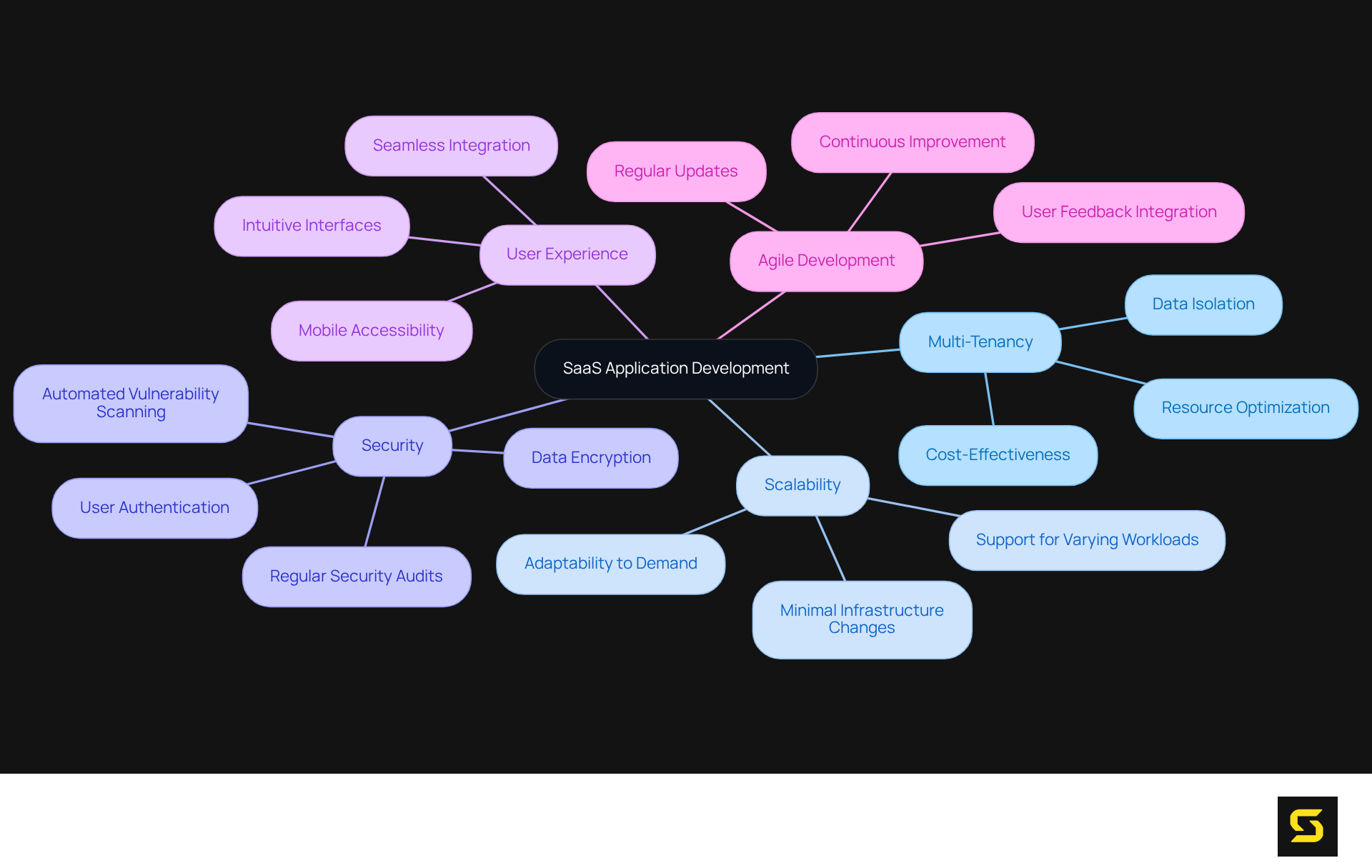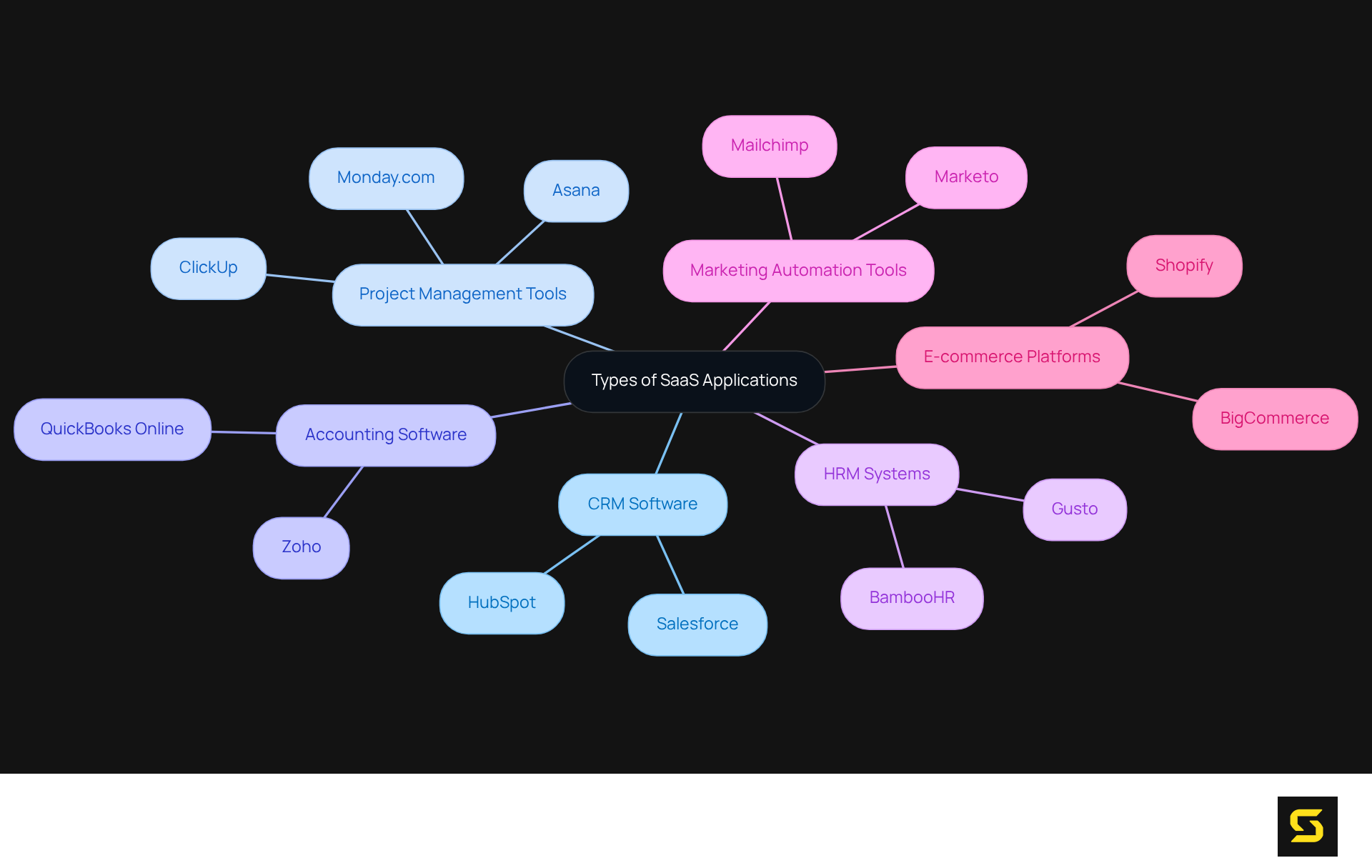Overview
SaaS application development services play a pivotal role in modern businesses by delivering scalable, cost-effective, and secure software solutions that significantly enhance operational efficiency and foster collaboration. Key features such as:
- Multi-tenancy
- Robust security protocols
- Exceptional adaptability
empower organizations to swiftly respond to market changes and optimize their technology infrastructure. By leveraging these capabilities, businesses can not only improve their operational resilience but also position themselves to capitalize on emerging opportunities in a competitive landscape. Embracing SaaS solutions is not just a strategic advantage; it is essential for organizations aiming to thrive in today's dynamic market.
Introduction
The rapid evolution of technology has ushered in a transformative approach to software delivery, known as Software as a Service (SaaS). This model not only revolutionizes how applications are accessed and utilized but also provides organizations with a unique opportunity to enhance operational efficiency and reduce costs. As businesses increasingly adopt cloud-based solutions, a critical question emerges: how can SaaS application development services be strategically leveraged to drive innovation and sustain a competitive edge in an ever-evolving market?
Defining SaaS Application Development Services
The creation of software programs hosted in the cloud and accessed via the internet is covered by SaaS application development services. This innovative model eliminates the need for local setup, enabling users to access programs from any internet-enabled device. By 2025, global spending on public cloud services is projected to reach $723 billion, underscoring the rapid adoption of cloud-based solutions. SaaS application development services operate on a subscription model, which not only reduces the necessity for significant hardware expenditures but also streamlines updates and maintenance, as these are centrally managed by the service provider.
Key characteristics of software applications include:
- Multi-tenancy, allowing multiple users to share the same application while keeping their data separate.
- Scalability accommodates varying user demands.
- Accessibility ensures users can connect from anywhere.
This flexibility is particularly appealing in today's business environment, where remote work is increasingly prevalent. For instance, companies like Zoom have effectively leveraged SaaS to deliver reliable video conferencing solutions, enhancing communication among remote teams with features such as virtual backgrounds and breakout rooms.
Moreover, the advantages of cloud-hosted software solutions extend beyond mere cost savings. They offer improved security protocols, with the average cost of a data breach estimated at $4.35 million, highlighting the critical importance of security in software services. Automatic updates and the capability to rapidly scale operations in response to shifting market conditions further enhance their appeal. As organizations prioritize agility and innovation, SaaS application development services have become an integral component of modern technology infrastructure, with industry leaders emphasizing their role in driving operational efficiency and user engagement. The current transition toward SaaS is evident, with 99% of enterprises expected to utilize at least one application by 2024, illustrating its essential role in contemporary organizational strategies. Furthermore, the global SaaS market is anticipated to grow at a CAGR of 13.7% until 2031, further emphasizing the growth and significance of this model in the industry.

The Significance of SaaS Development in Today's Market
In today's fast-paced digital environment, software development stands as a critical pillar for businesses striving to maintain a competitive edge. The global software-as-a-service market is projected to reach approximately $300 billion by 2025, driven by the increasing demand for scalable and cost-effective solutions. Organizations are adopting software applications to boost operational efficiency, lower IT costs, and foster collaboration among teams. Moreover, the adaptability provided by saas application development services empowers organizations to swiftly respond to shifting market dynamics and customer needs, solidifying its role as an essential strategy for growth and innovation. As companies place greater emphasis on digital transformation, the significance of software development continues to escalate.

Key Features and Components of SaaS Application Development
Key aspects of SaaS application development services hinge on multi-tenancy, which allows multiple users to access a single instance while ensuring their data remains distinct and secure. This architecture not only optimizes resource utilization but also enhances cost-effectiveness for businesses. Scalability stands as another vital component, enabling organizations to adjust their usage based on demand without incurring significant infrastructure changes. In fact, SaaS solutions can seamlessly support one user or a million users with minimal adjustments, demonstrating their adaptability to varying workloads.
Security is paramount in SaaS solutions. Robust measures such as data encryption, automated vulnerability scanning, and regular security audits are employed to protect sensitive information. Industry specialists emphasize that these security protocols are essential for maintaining client trust and safeguarding against potential threats. Furthermore, intuitive interfaces and seamless integration with other software tools are crucial for enhancing user experience, ensuring that applications meet the diverse requirements of businesses. Agile development practices further bolster the effectiveness of software solutions by facilitating regular updates based on user feedback, ensuring that programs remain relevant and efficient. Collectively, these characteristics enhance the effectiveness and appeal of software solutions across various sectors, establishing SaaS application development services as a strategic choice for organizations aiming to leverage technology for growth.

Types of SaaS Applications and Their Use Cases
SaaS application development services are essential tools that can be classified into various types, each addressing unique organizational needs. For instance, Customer Relationship Management (CRM) software, such as Salesforce, plays a crucial role in assisting organizations with managing customer interactions and data. Similarly, project management tools like Asana facilitate team collaboration and task tracking, enhancing productivity. Furthermore, accounting software like QuickBooks Online simplifies financial management for organizations of all sizes, making it an invaluable resource. Other notable examples include:
- Human Resource Management (HRM) systems
- Marketing automation tools
- E-commerce platforms
Each of these applications exemplifies the flexibility of SaaS application development services in addressing specific operational challenges, solidifying their status as indispensable assets for modern businesses.

Conclusion
The exploration of SaaS application development services reveals their transformative impact on modern business operations. By facilitating cloud-based software solutions, these services empower organizations to enhance efficiency, reduce costs, and swiftly adapt to changing market demands. The subscription-based model alleviates the burden of hardware investments and ensures users benefit from continuous updates and improved security measures.
Key insights throughout the article underscore the significance of SaaS in today’s digital landscape. The multi-tenancy feature optimizes resource utilization, while scalability enables businesses to grow without incurring excessive costs. Security remains a top priority, with advanced protocols safeguarding sensitive data. Moreover, the diverse range of SaaS applications—from CRM systems to project management tools—demonstrates their versatility in addressing various operational needs.
In light of these insights, embracing SaaS application development services emerges as a strategic imperative for organizations aiming to thrive in an increasingly competitive environment. As the SaaS market continues to expand, businesses must prioritize digital transformation and leverage the advantages of cloud-based solutions to remain agile and innovative. The future of business technology is undoubtedly intertwined with the evolution of SaaS, making it essential for organizations to stay ahead of the curve and fully harness its potential.
Frequently Asked Questions
What are SaaS application development services?
SaaS application development services involve creating software programs that are hosted in the cloud and accessed via the internet, eliminating the need for local setup.
What is the projected spending on public cloud services by 2025?
Global spending on public cloud services is projected to reach $723 billion by 2025.
How does the subscription model of SaaS benefit users?
The subscription model reduces the need for significant hardware expenditures and streamlines updates and maintenance, which are managed centrally by the service provider.
What are the key characteristics of SaaS applications?
Key characteristics include multi-tenancy (allowing multiple users to share the same application while keeping their data separate), scalability (accommodating varying user demands), and accessibility (ensuring users can connect from anywhere).
Why is SaaS particularly appealing in today's business environment?
SaaS is appealing due to its flexibility, which supports remote work and enhances communication among teams, as demonstrated by companies like Zoom.
What security advantages do cloud-hosted software solutions offer?
Cloud-hosted software solutions provide improved security protocols, which are critical given the average cost of a data breach is estimated at $4.35 million.
How do automatic updates and scalability contribute to the appeal of SaaS?
Automatic updates ensure that software is always up-to-date, while the ability to rapidly scale operations allows organizations to respond quickly to shifting market conditions.
What is the expected utilization of SaaS applications among enterprises by 2024?
It is expected that 99% of enterprises will utilize at least one SaaS application by 2024.
What is the anticipated growth rate of the global SaaS market until 2031?
The global SaaS market is anticipated to grow at a compound annual growth rate (CAGR) of 13.7% until 2031.





